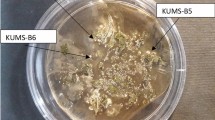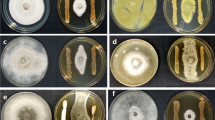Abstract
Citrus Canker disease is one of the most important disease in citrus production worldwide caused by gram-negative bacterial pathogen Xanthomonas citri subsp. citri, leading to great economic losses. Currently, a spray of copper-based bactericides is the primary measure for citrus canker management. However, these measures can lead to the contamination of soil by metal contamination, but also the development of copper-resistant Xanthomonas populations. Considering the need to discovery new alternatives to control the citrus canker disease, actinomycetes isolated from the Brazilian Caatinga biome and their crude extracts were tested against different strains of Xanthomonas citri subsp. citri. Streptomyces sp. Caat 1-54 crude extract showed the highest antibiotic activity against Xcc. The crude extract dereplication was performed by LC–MS/MS. Through bioassay-guided fractionation strategy, the antimicrobial activity was assigned to Lysolipins, showing a MIC around 0.4–0.8 µg/mL. Growth media optimization using statistical experimental design increased the Lysolipins production in three-fold production. The preventive and curative effects of the optimized crude extract obtained by experimental design of Caat-1-54 against citrus canker were evaluated in potted ‘Pera’ sweet orange nursery trees. Caat 1-54 extract was effective in preventing new infections by Xcc on leaves but was not able to reduce Xcc population in pre-established citrus canker lesions. Streptomyces sp. Caat 1-54 extract is a promising, environmentally-friendly source of antimicrobial compound to protect citrus trees against citrus canker.








Similar content being viewed by others
Abbreviations
- CID:
-
Collision-induced dissociation
- RSM:
-
Response surface methodology
- MIC:
-
Minimum inhibitory concentration
- DMSO:
-
Dimethyl sulfoxide
- MTT:
-
Thiazolyl blue tetrazolium bromide
- TLC:
-
Thin-layer chromatography
References
Schaad NW, Postnikova E, Lacy G, Sechler A, Agarkova IV, Stromberg PE, Stromberg VK, Vidaver AM (2006) Emended classification of xanthomonad pathogens on citrus. Papers in Plant Pathology, p 96
Graham JH, Gottwald TR, Cubero J, Achor DS (2004) Xanthomonas axonopodis pv. citri: factors affecting successful eradication of citrus canker. Mol Plant Pathol 5:1–15
Canteros B (2004) Management of citrus canker in Argentina. A review. Proc Int Soc Citric 2:696–704
Behlau F, Scandelai LHM, da Silva Junior GJ, Lanza FE (2017) Soluble and insoluble copper formulations and metallic copper rate for control of citrus canker on sweet orange trees. Crop Prot 94:185–191
Behlau F, Belasque J (2014) Cancro cítrico: a doença e seu controle. Fundecitrus, Araraquara
Zhu B, Alva A (1993) Trace metal and cation transport in a sandy soil with various amendments. Soil Sci Soc Am J 57:723–727
Berdy J (1995) Are actinomycetes exhausted as source of secondary metabolites? Proceedings of the 9th international symposium on the biology of actinomycetes, pp 13–34
Goodfellow M, Fiedler H-P (2010) A guide to successful bioprospecting: informed by actinobacterial systematics. Antonie Van Leeuwenhoek 98:119–142
Weber T, Charusanti P, Musiol-Kroll EM, Jiang X, Tong Y, Kim HU, Lee SY (2015) Metabolic engineering of antibiotic factories: new tools for antibiotic production in actinomycetes. Trends Biotechnol 33:15–26
Tiwari K, Gupta RK (2013) Diversity and isolation of rare actinomycetes: an overview. Crit Rev Microbiol 39:256–294
Knight V, Sanglier J-J, DiTullio D, Braccili S, Bonner P, Waters J, Hughes D, Zhang L (2003) Diversifying microbial natural products for drug discovery. Appl Microbiol Biotechnol 62:446–458
de Oliveira G, Araújo MB, Rangel TF, Alagador D, Diniz-Filho JAF (2012) Conserving the Brazilian semiarid (Caatinga) biome under climate change. Biodivers Conserv 21:2913–2926
Pacchioni RG, Carvalho FM, Thompson CE, Faustino AL, Nicolini F, Pereira TS, Silva RC, Cantão ME, Gerber A, Vasconcelos AT (2014) Taxonomic and functional profiles of soil samples from Atlantic forest and Caatinga biomes in northeastern Brazil. MicrobiologyOpen 3:299–315
Rateb ME, Houssen WE, Harrison WTA, Deng H, Okoro CK, Asenjo JA, Andrews BA, Bull AT, Goodfellow M, Ebel R, Jaspars M (2011) Diverse metabolic profiles of a streptomyces strain isolated from a hyper-arid environment. J Nat Prod 74:1965–1971
Mohammadipanah F, Wink J (2015) Actinobacteria from arid and desert habitats: diversity and biological activity. Front Microbiol 6:1541
Ruiz B, Chávez A, Forero A, García-Huante Y, Romero A, Sánchez M, Rocha D, Sánchez B, Rodríguez-Sanoja R, Sánchez S (2010) Production of microbial secondary metabolites: regulation by the carbon source. Crit Rev Microbiol 36:146–167
Sanchez S, Demain AL (2002) Metabolic regulation of fermentation processes. Enzyme Microbiol Technol 31:895–906
Latha S, Sivaranjani G, Dhanasekaran D (2017) Response surface methodology: a non-conventional statistical tool to maximize the throughput of Streptomyces species biomass and their bioactive metabolites. Crit Rev Microbiol 43:567–582
Managamuri U, Vijayalakshmi M, Poda S, Ganduri V, Babu RS (2016) Optimization of culture conditions by response surface methodology and unstructured kinetic modeling for bioactive metabolite production by Nocardiopsis litoralis VSM-8. 3 Biotech 6:219
Ahsan T, Chen J, Wu Y, Irfan M (2017) Application of response surface methodology for optimization of medium components for the production of secondary metabolites by Streptomyces diastatochromogenes KX852460. AMB Express 7:96
Silva LJ, Souza DT, Genuario DB, Hoyos HAV, Santos SN, Rosa LH, Zucchi TD, Melo IS (2018) Rhodococcus psychrotolerans sp. nov., isolated from rhizosphere of Deschampsia antarctica. Antonie Van Leeuwenhoek 111:629–636
Thangapandian V, Philip Ruban A, Prabhu D, Lingakumar K (2011) Isolation and characterization of antibiotics producing actinomycetes from soil samples of Senbagadaruvi in Western Ghats. Biores Bull 4:254
McFarland J (1907) The nephelometer: an instrument for estimating the number of bacteria in suspensions used for calculating the opsonic index and for vaccines. J Am Med Assoc 49:1176–1178
Bauer AW, Kirby WM, Sherris JC, Turck M (1966) Antibiotic susceptibility testing by a standardized single disk method. Am J Clin Pathol 45:493–496
Kuster E, Williams ST (1964) Selection of media for isolation of Streptomycetes. Nature 202:928–929
Howland JL (1996) Short protocols in molecular biology. In Ausubel F, Brent R, Kingston RE, Moore DD, Seidman JG, Smith JA, Struhl K (eds) Biochemical education, vol 24, 3rd edn. Wiley, New York, pp 68–68 ISBN: 0-471-13781-2
Shirling EB, Gottlieb D (1972) Cooperative description of type strains of streptomyces. Int J Syst Evol Microbiol 22:265–394
CHANDLER VL, SHAW RD (1946) Dropping device for cylinder plate assay of penicillin. Science 104:275–275
Temirkhanova ZU, Gashimova P, Safonova NV, Moroz AF, Khazenson LV (1999) A nutrient medium for the isolation and cultivation of Campylobacter. Zhurnal mikrobiologii, epidemiologii, i immunobiologii 6:27–30
da Silva AR, Ferro JA, Reinach F, Farah C, Furlan L, Quaggio R, Monteiro-Vitorello C, Van Sluys M, Almeida Na, Alves L (2002) Comparison of the genomes of two Xanthomonas pathogens with differing host specificities. Nature 417:459
Viloria Z, Drouillard D, Graham J, Grosser J (2004) Screening triploid hybrids of ‘Lakeland’limequat for resistance to citrus canker. Plant Dis 88:1056–1060
Drautz H, Keller-Schierlein W, Zähner H (1975) Metabolic products of microorganisms, 149. Lysolipin I, a new antibiotic from Streptomyces violaceoniger (author’s transl). Arch Microbiol 106:175–190
Lopez P, Hornung A, Welzel K, Unsin C, Wohlleben W, Weber T, Pelzer S (2010) Isolation of the lysolipin gene cluster of Streptomyces tendae Tü 4042. Gene 461:5–14
Winter DK, Sloman DL, Porco Jr JA (2013) Polycyclic xanthone natural products: structure, biological activity and chemical synthesis. Nat Prod Rep 30:382–391
Bockholt H, Udvarnoki G, Rohr J, Mocek U, Beale JM, Floss HG (1994) Biosynthetic studies on the xanthone antibiotics lysolipins X and I. J Org Chem 59:2064–2069
Gallo M, Katz E (1972) Regulation of secondary metabolite biosynthesis: catabolite repression of phenoxazinone synthase and actinomycin formation by glucose. J Bacteriol 109:659–667
Uguru GC, Stephens KE, Stead JA, Towle JE, Baumberg S, McDowall KJ (2005) Transcriptional activation of the pathway-specific regulator of the actinorhodin biosynthetic genes in Streptomyces coelicolor. Mol Microbiol 58:131–150
Hodgson DA (2000) Primary metabolism and its control in streptomycetes: a most unusual group of bacteria. Adv Microb Physiol 42:47–238
Brückner R, Titgemeyer F (2002) Carbon catabolite repression in bacteria: choice of the carbon source and autoregulatory limitation of sugar utilization. FEMS Microbiol Lett 209:141–148
Demain AL (1989) Carbon source regulation of idiolite biosynthesis in actinomycetes. CRC Press, Boca Raton
Piepersberg W, Distler J (1997) Aminoglycosides and sugar components in other secondary metabolites. In: Rehm H-J, Reed G (eds) Biotechnology set, 2nd edn. Wiley, Hoboken, pp 397–488
Sørensen JL, Giese H (2013) Influence of carbohydrates on secondary metabolism in Fusarium avenaceum. Toxins 5:1655–1663
Singh V, Haque S, Niwas R, Srivastava A, Pasupuleti M, Tripathi C (2017) Strategies for fermentation medium optimization: an in-depth review. Front Microbiol. 7:2087
Pauletti PM, Cintra LS, Braguine CG, da Silva Filho AA, Silva MLA e., Cunha WR, Januário AH (2010) Halogenated indole alkaloids from marine invertebrates. Marine Drugs 8:1526–1549
Jančič S, Frisvad JC, Kocev D, Gostinčar C, Džeroski S, Gunde-Cimerman N (2016) Production of secondary metabolites in extreme environments: food-and airborne Wallemia spp. produce toxic metabolites at hypersaline conditions. PLoS ONE 11:e0169116
Shapiro S (1989) Regulation of secondary metabolism in actinomycetes. CRC Press, Boca Raton
Monteiro VN, SILVA R (2009) Aplicações industriais da biotecnologia enzimática. Revista Processos Químicos 3:9–23
Schaechter M, Maaløe O, Kjeldgaard NO (1958) Dependency on medium and temperature of cell size and chemical composition during balanced growth of Salmonella typhimurium. Microbiology 19:592–606
Buru AS, Pichika MR, Neela V, Mohandas K (2014) In vitro antibacterial effects of Cinnamomum extracts on common bacteria found in wound infections with emphasis on methicillin-resistant Staphylococcus aureus. J Ethnopharmacol 153:587–595
Funding
This work was supported by CAPES (Coordenação de Aperfeiçoamento de Pessoal de Nível Superior) and FAPESP (Fundação de Amparo à Pesquisa do Estado de São Paulo) - process (2016-22023-0) with financial support and fellowships.
Author information
Authors and Affiliations
Corresponding author
Ethics declarations
Conflict of interest
The authors declare that they have no conflicts of interest.
Electronic supplementary material
Below is the link to the electronic supplementary material.
Rights and permissions
About this article
Cite this article
Rodrigues, J.P., Peti, A.P.F., Figueiró, F.S. et al. Bioguided isolation, characterization and media optimization for production of Lysolipins by actinomycete as antimicrobial compound against Xanthomonas citri subsp. citri. Mol Biol Rep 45, 2455–2467 (2018). https://doi.org/10.1007/s11033-018-4411-5
Received:
Accepted:
Published:
Issue Date:
DOI: https://doi.org/10.1007/s11033-018-4411-5




